We occasionally link to goods offered by vendors to help the reader find relevant products. Some of these may be affiliate based, meaning we earn small commissions (at no additional cost to you) if items are purchased. Here is more about what we do.
Carbs are not the enemy.
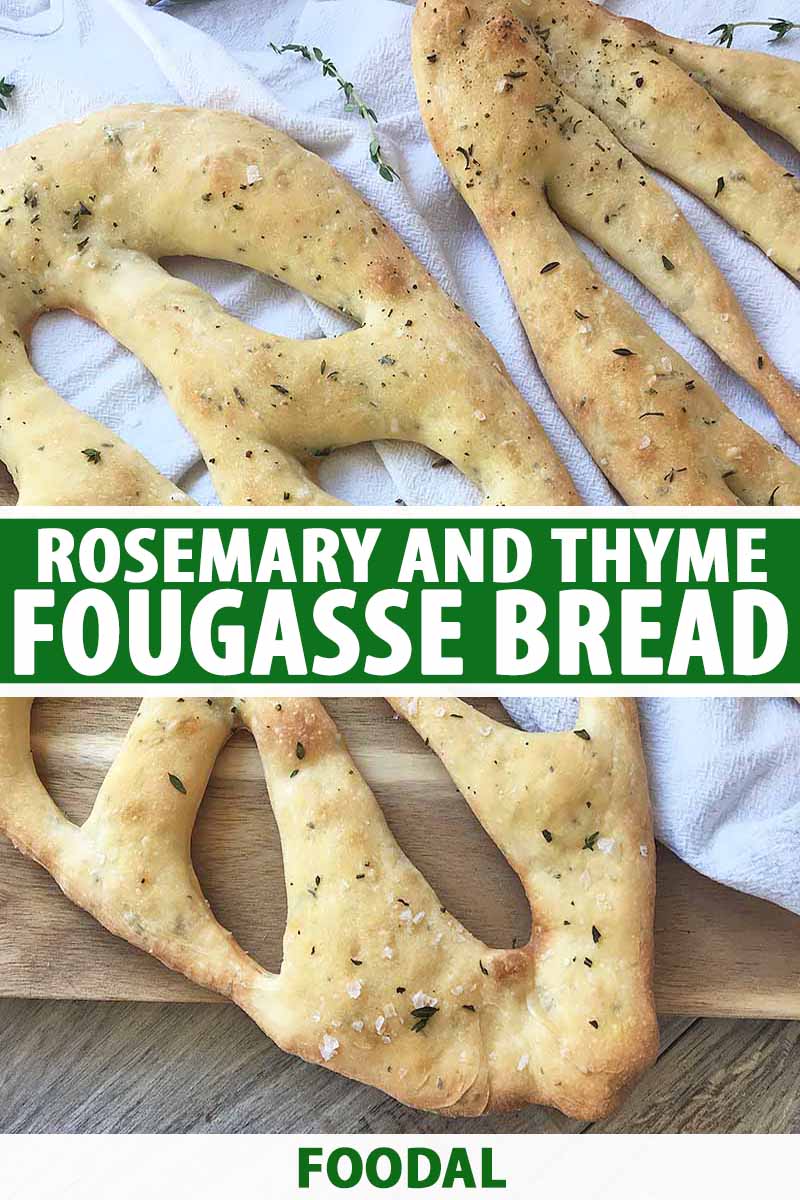
It’s what I tell myself every single time I make bread, eat bread, and savor every big, fluffy mouthful of bread. Which obviously means I mutter the phrase more often than I would like to admit.
How could they be evil, when they look so beautiful in this rustic fougasse?
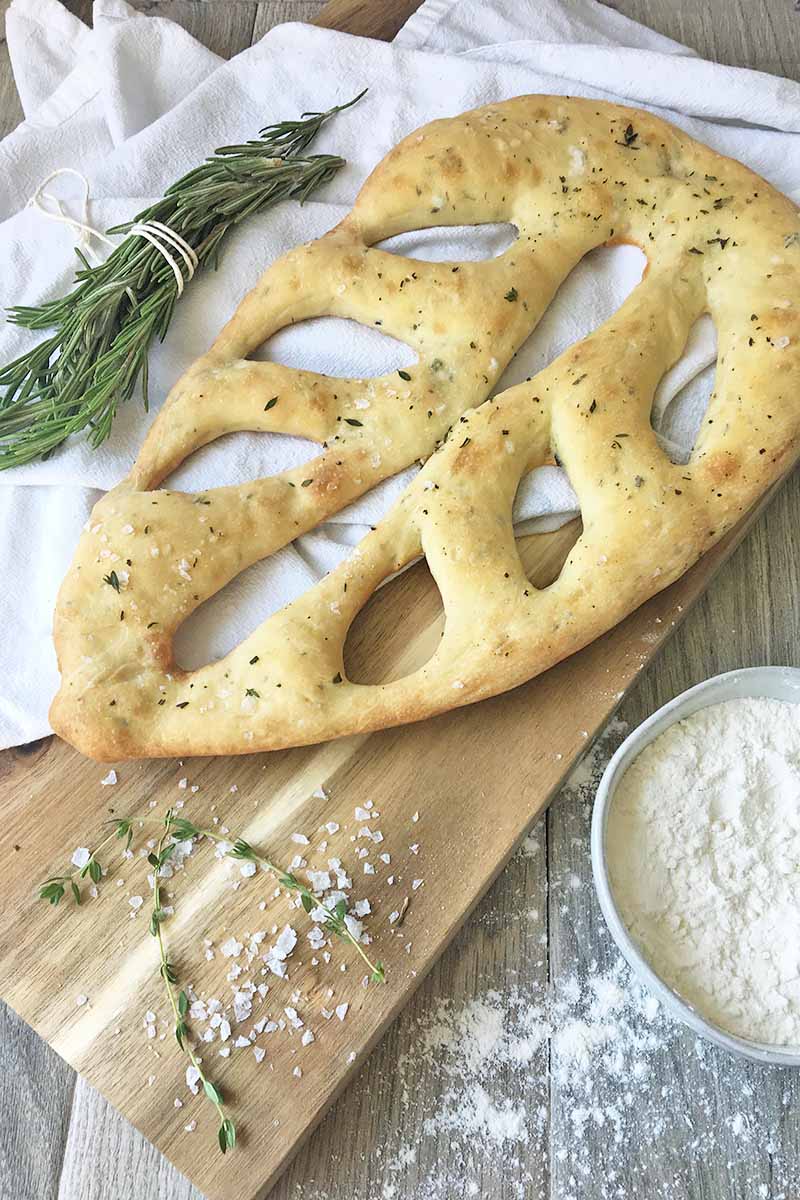
Fougasse is a stunning French flatbread that is similar to Italian focaccia. The crisp crust gives way to a spongy, slightly chewy crumb.
The unique design also adds to its charm. Fougasse is traditionally shaped to look like a rustic leaf, with freeform slits mimicking the veins and stem of the leaf.

There are no rolling pins, no molds, no bread pans – you design and shape it right on the sheet pan. Simply embrace the natural beauty of whatever design you want to make!
It’s perfect served warm from the oven, torn into pieces with your hands, or eaten with oil and vinegar as an appetizer before a meal. Or even serve during the meal! A rustic dish like our poulet saute a la paysanne Provencale would be the best main course to dip big chunks into the savory white wine sauce.

Foodal’s version of this bread mixes fresh rosemary and thyme into the dough, which creates an intoxicating burst of herbal aromas every time you shape and cut it.
And the scent intensifies even more as it bakes.
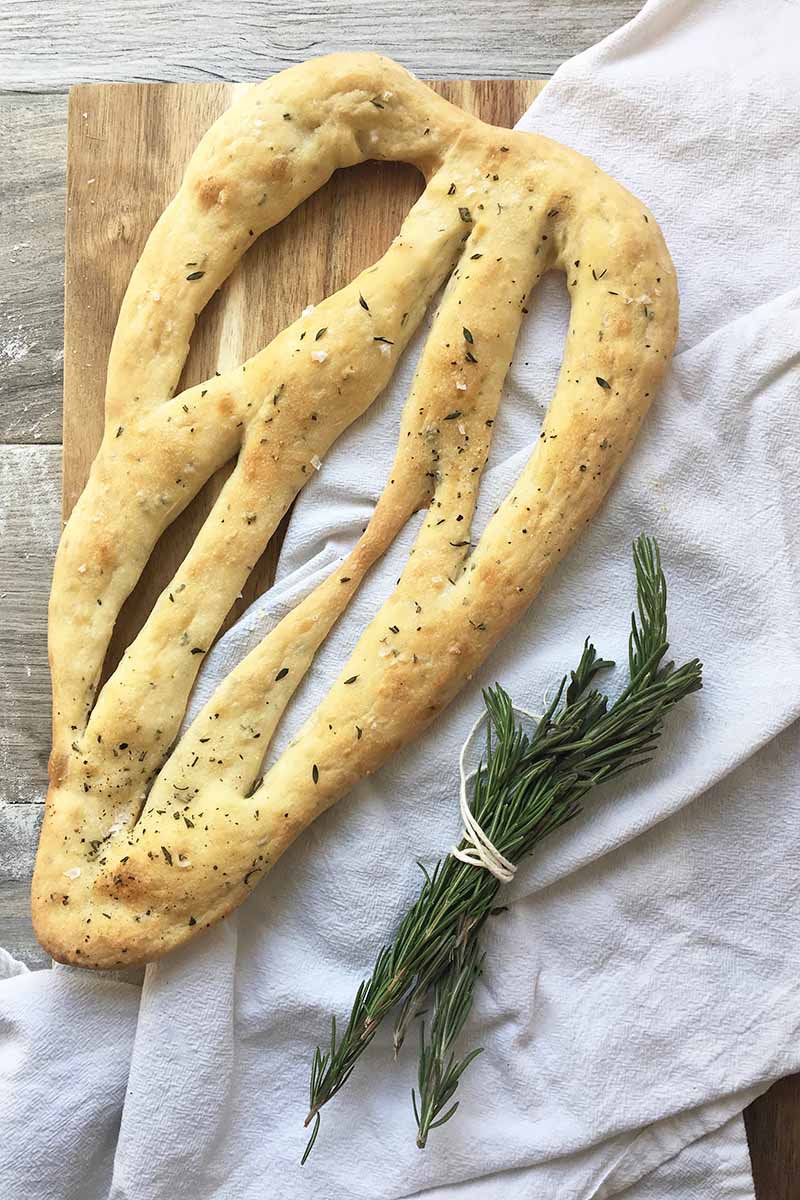
I like to time the baking process perfectly if I know friends and family are coming over – as they arrive, and open the door to the house, they are immediately greeted by the most amazing smells from the yeast and the lightly toasted herbs of the freshly made fougasse.
Once you tear off a piece, still warm from the oven, bite into the crust and enjoy the soft interior, you’ll soon be whispering the same five words along with me:
Carbs are not the enemy…
Print
French Fougasse Bread with Herbs
- Total Time: 19 minute
- Yield: 2 loaves 1x
Description
Fougasse is a beautiful French flatbread that is similar to Italian focaccia. Try Foodal’s version, mixed with fresh rosemary and thyme.
Ingredients
For the Preferment:
- 1/2 cup warm water
- 1/4 teaspoon active dry yeast
- 1 cup all-purpose flour
For the Dough:
- 1/2 cup warm water
- 1/2 teaspoon active dry yeast
- 2 tablespoons olive oil
- 1 1/2 cups all-purpose flour, plus more for dusting
- 1 teaspoon finely chopped rosemary
- 1 teaspoon finely chopped thyme
- 1/2 teaspoon coarse salt
For the Garnish:
- 1 tablespoon olive oil
- 1 teaspoon coarse salt
- 1 teaspoon finely chopped rosemary
- 1 teaspoon finely chopped thyme
Instructions
For the Preferment:
- Pour the warm water into a medium bowl and whisk in the yeast. Let the mixture stand for 10 minutes.
- Stir in the flour with a sturdy spoon and mix until it forms a shaggy dough. Continue to stir until the mixture is smooth and slightly elastic. It will be a little loose.
- Cover the bowl with plastic wrap, and set aside for 3-4 hours at room temperature, or up to 12 hours in the refrigerator.
For the Bread:
- Pour the warm water into the bowl of a stand mixer. Add the yeast, whisk by hand to blend, and let the mixture stand for 10 minutes.
- Fit the stand mixer with the dough hook attachment. Add the preferment and the olive oil and mix on low speed for 1 minute. Add the flour, rosemary, thyme, and salt. Mix on low speed until it comes together in a cohesive mass, about 2-3 minutes. It will look wet and sticky.
- Cover the bowl with plastic wrap, and let it rest for 20 minutes to allow it to fully hydrate before any further kneading.
- Turn the mixer to medium-low and continue to mix until the dough is firm, elastic, and smooth, about 5-7 minutes. It will still be soft. Add more flour, one tablespoon at a time, if the dough feels too sticky to work with.
- Lightly oil a large bowl, and transfer the dough to the bowl, rolling it around in the oil. Cover tightly with plastic wrap and let the dough rise until doubled in size, 1 1/2-2 hours.
- Turn the dough out onto a lightly floured work surface. Gently press down on the dough to expel some of the air bubbles. Cut the dough in half, and transfer each half to two baking sheets lined with parchment paper or silicone mats. Using your hands, lightly stretch and form the dough into a large leaf shape.
- Make the design, using a sharp knife to cut slits in the dough to resemble leaf veins: one slit down the center, then two or three slits at an angle on each side of the center. If using silicone mats, be careful to not cut through the material. Gently stretch out each slit to make decorative holes.
- Cover the dough loosely with plastic wrap, and let the dough proof for 30-40 minutes.
- While the dough is proofing, preheat the oven to 425°F.
- Gently brush the surface of the proofed dough with olive oil, and sprinkle salt and chopped herbs on top. Bake for 20-25 minutes, until the bread is golden brown. Transfer to a cooling rack to cool slightly. Serve while still warm.
- Prep Time: 30 minutes
- Cook Time: 20-25 minutes
- Category: Bread
- Method: Baking
- Cuisine: Baked Goods
Keywords: fougasse, flatbread, bread, rosemary, thyme, yeast, all-purpose flour
Cooking by the Numbers…
Step 1 – Make the Preferment
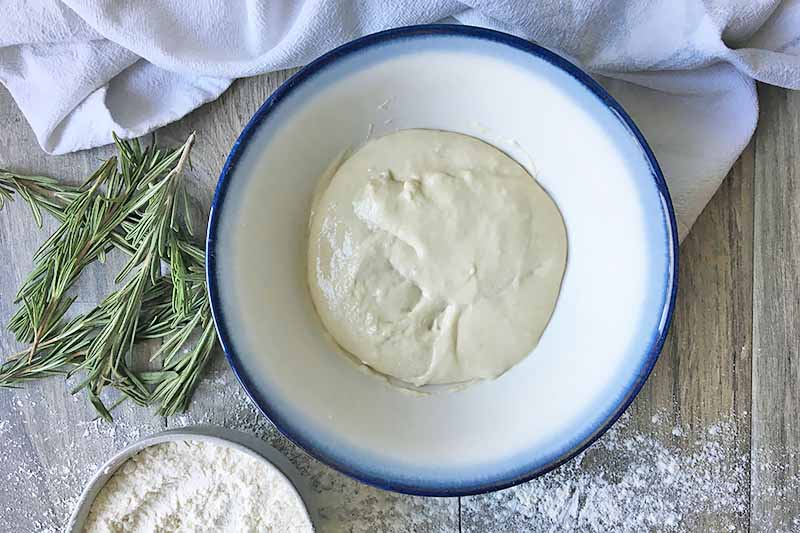
A preferment, also called a yeast starter, is a fermented mixture that helps give fermentation a head start before making the bread dough. It contributes leavening power and additional flavor.
Pour the warm water into a medium bowl and whisk in the yeast. Let the mixture stand for 10 minutes. Stir in the all-purpose flour with a sturdy spoon and mix until it forms a shaggy mixture. Continue to stir until the mixture is smooth and slightly elastic. It will be a little loose.
Cover the bowl with plastic wrap, and set aside for 3 to 4 hours at room temperature, or up to 12 hours in the refrigerator.
Step 2 – Mix and Rest the Dough
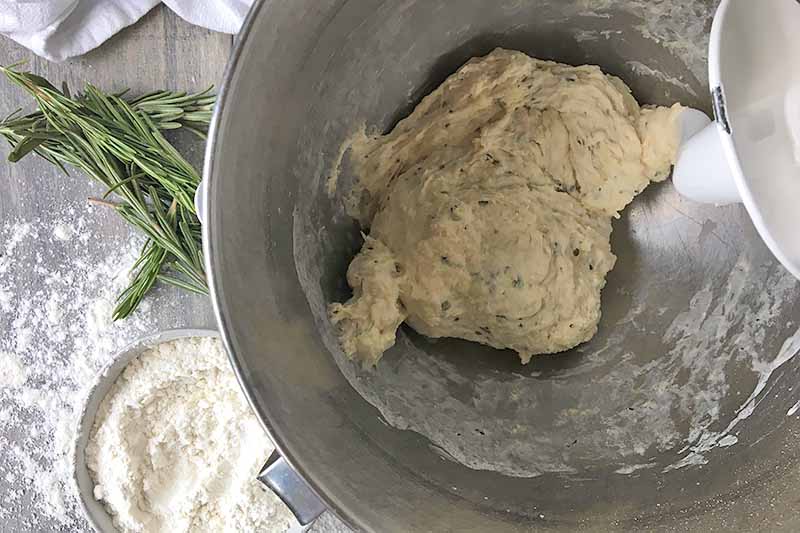
Pour the warm water into the bowl of a stand mixer. Add the yeast, whisk by hand to blend, and let the mixture stand for 10 minutes.
Fit the stand mixer with the hook attachment. Add the preferment and the olive oil and mix on low speed for 1 minute. Add the flour, rosemary, thyme, and salt. Mix on low speed until it comes together in a cohesive mass, about 2 to 3 minutes. It will look wet and sticky.
Remove the bowl from the stand mixer, and cover the bowl with plastic wrap. Let it rest for 20 minutes to allow it to fully hydrate before further kneading.
Step 3 – Knead and Proof

After it has rested, Turn the mixer to medium-low and continue to mix until the it is firm, elastic, and smooth, about 5 to 7 minutes.
Lightly oil a large bowl, place the dough inside, and lightly roll it in the oil. Cover tightly with plastic wrap and let it rise until doubled in size, 1 1/2 to 2 hours.
Step 4 – Form

Turn the dough out onto a lightly floured work surface. Gently press down on the dough to expel some of the air bubbles. Cut the dough in half, and transfer each half to two baking sheets lined with parchment paper or silicone mats.

Using your hands, lightly stretch and form the dough into a large leaf shape.
Step 5 – Cut Slits
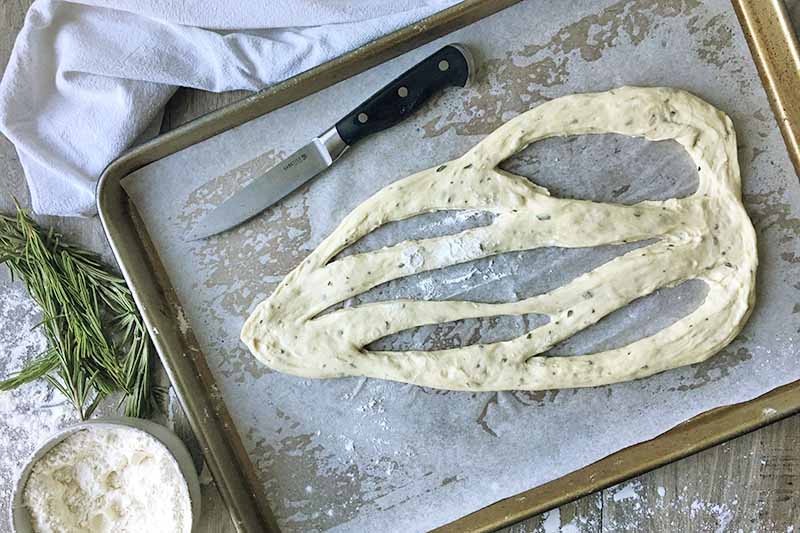
Make the design, using a sharp knife to cut slits in the dough to resemble leaf veins: one slit down the center, then two or three slits at an angle on each side of the center. If using silicone mats, be careful to not cut through the material. Gently stretch out each slit to make decorative holes.
Use your creativity to make your own unique designs!
Step 6 – Proof
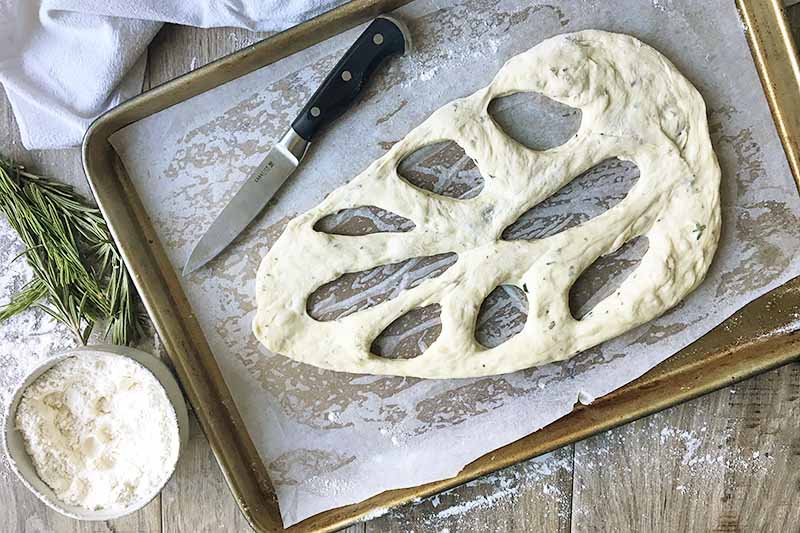
Cover both baking sheets loosely with plastic wrap, and let the dough proof for 30 to 40 minutes.
Step 7 – Garnish

Gently brush the surface of the proofed dough with olive oil, and sprinkle salt and chopped herbs on top.
Step 8 – Bake
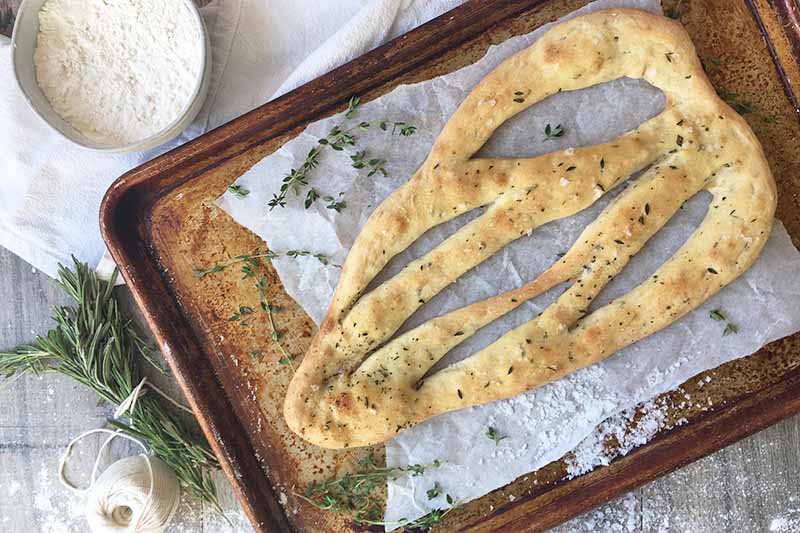
Bake for 20 to 25 minutes, until the bread is golden brown. Transfer to a cooling rack to cool slightly. Serve while still warm with butter, or double up on the fresh herbal flavors and dip in herb-infused olive oil.
A Leaf Like No Other
This bread is a natural beauty.
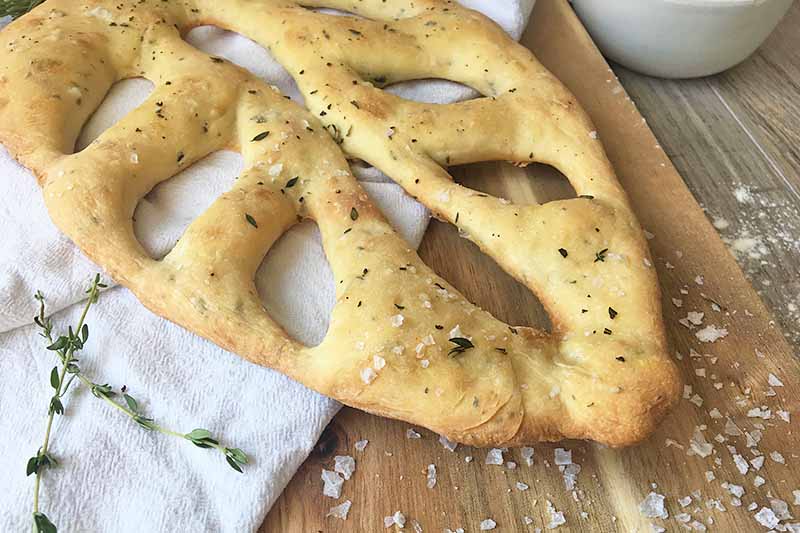
With its freeform design, the leaf-like fougasse is a unique showpiece, and an entertaining start to a meal.
It is meant to be served with the same effortless approach used to shape it. Just place it on a big tray, no bread knife required, and encourage everyone to tear off pieces with their hands.
It’s fun, inviting, and undeniably delicious.
With this recipe, I’m sure I can convince you that carbs are an ally, not an enemy. Remember that yeast in bread, when consumed in moderation, can actually be good for the gut!
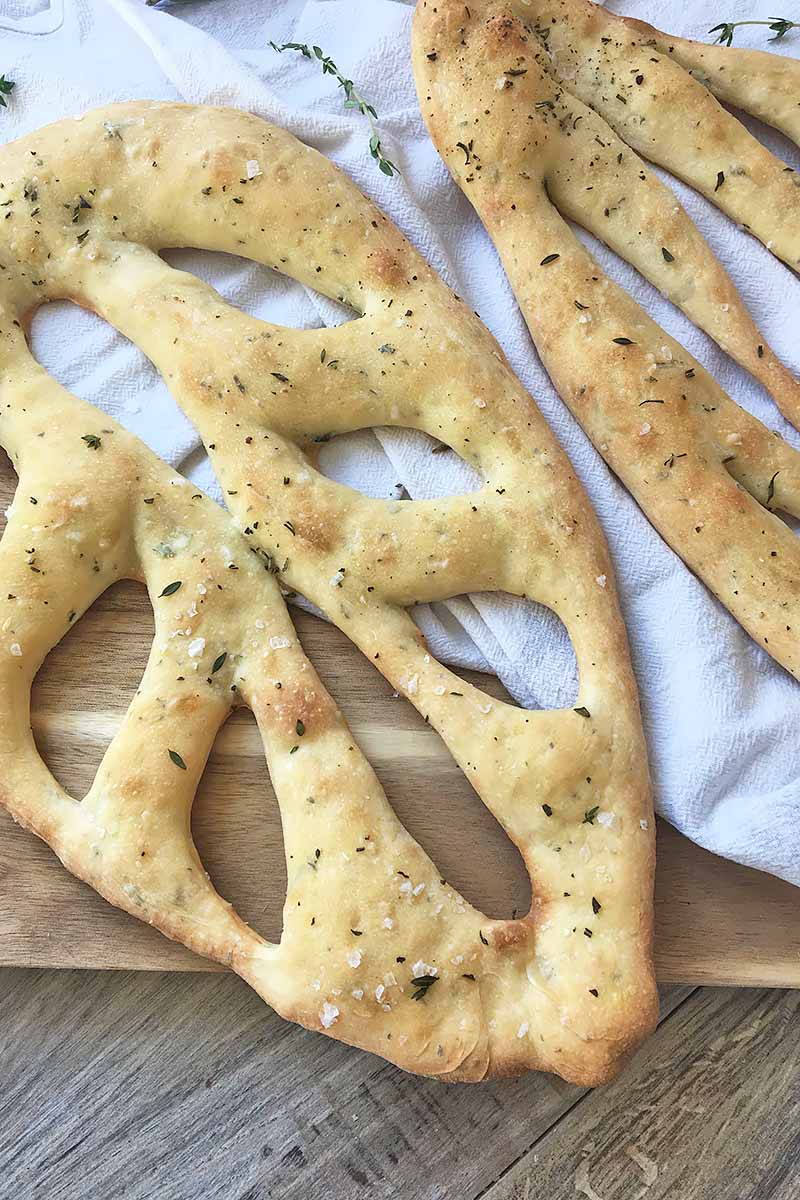
I want to invite all of your to try and rate this recipe, and I hope you enjoy it! If you want to bake more bread at home, we have so many great recipes, and many that are gluten free as well, like our sorghum bread.
What do you think of the unique design of this fougasse? Are you excited to try your own cool shapes when you make it? Let us know what you think by writing to us in the comment section below.
Photos by Nikki Cervone, © Ask the Experts, LLC. ALL RIGHTS RESERVED. See our TOS for more details. Originally published on January 14, 2009. Last updated: November 1, 2020 at 12:05 pm. Recipe adapted from The Art and Soul of Baking, available on Amazon.
Nutritional information derived from a database of known generic and branded foods and ingredients and was not compiled by a registered dietitian or submitted for lab testing. It should be viewed as an approximation.
About Nikki Cervone
Nikki Cervone is an ACS Certified Cheese Professional and cheesemonger living in Pittsburgh. Nikki holds an AAS in baking/pastry from Westmoreland County Community College, a BA in Communications from Duquesne University, and an MLA in Gastronomy from Boston University. When she's not nibbling on her favorite cheeses or testing a batch of cupcakes, Nikki enjoys a healthy dose of yoga, wine, hiking, singing in the shower, and chocolate. Lots of chocolate.



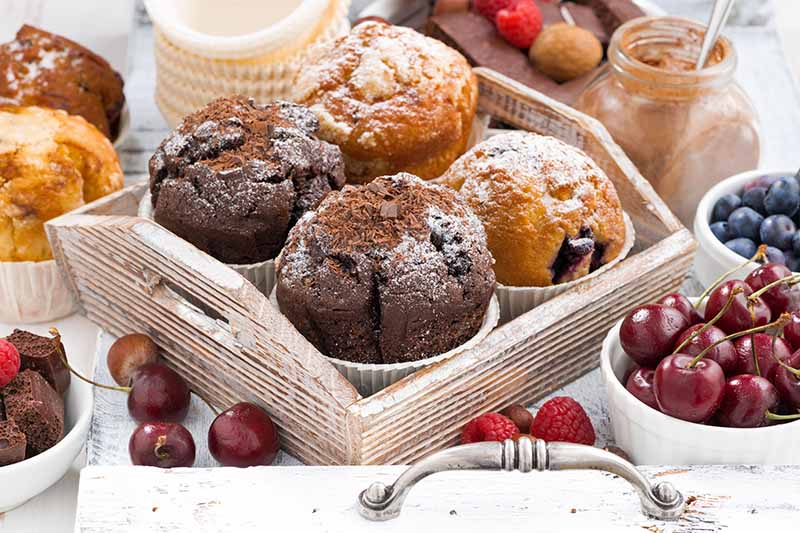
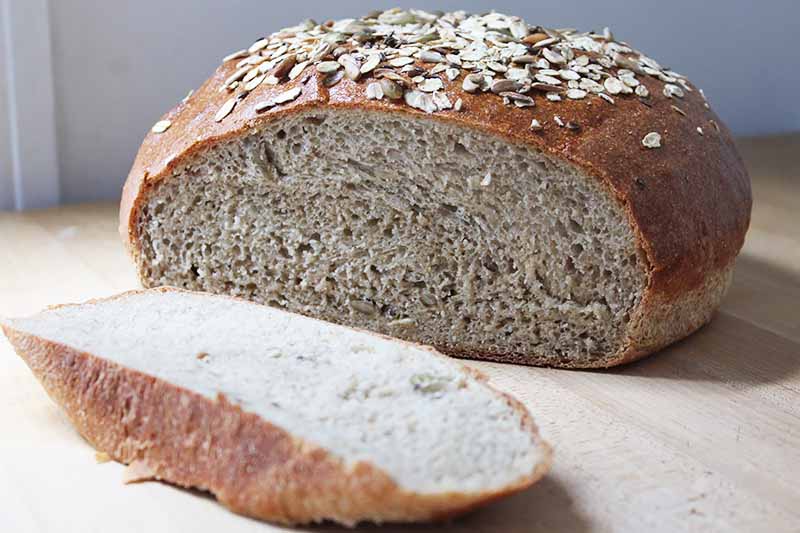
I’ve been looking for a fun new way to use up the bounty of herbs that have overtaken my garden. This is wonderful! The dough itself is lovely and wow- what a punch those fresh herbs add! My own fuss was the resting time between each stage. I know patience is a virtue, but it is one that I lack. The end result is stunning though, and I can’t wait to surprise my girls with this, some good dipping oils and 17 year balsamic, and wine this afternoon. Thank you again for the inspiration! Bon Appetit!
★★★★
Kat, I’m so pleased that you enjoyed the recipe! And believe me: I KNOW the struggle of impatiently waiting for the dough to rise! But the end results are so worth it. Especially if it involves a delicious vinegar and wine!
Any chance you have this recipe in gram weight? It’s how I bake.Thanks. Looks delish. Jo